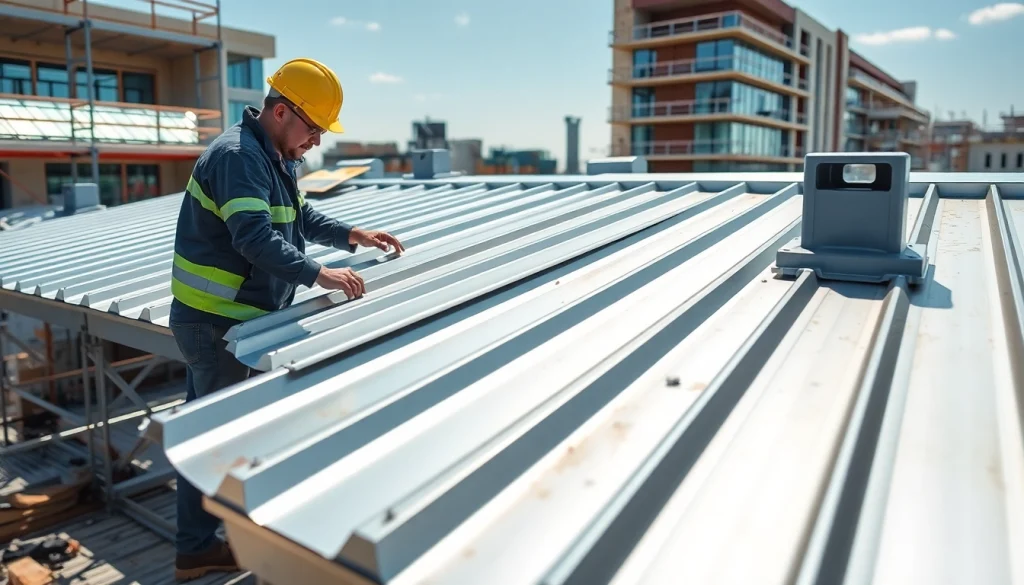Understanding Commercial Metal Roofing
What is Commercial Metal Roofing?
Commercial metal roofing is a type of roofing system designed specifically for commercial buildings, characterized by the use of metal panels or shingles to create a protective layer over the structural framework of the building. Unlike conventional roofing materials such as asphalt shingles or clay tiles, commercial metal roofing is typically formed from steel, aluminum, copper, or zinc, which provides superior durability and longevity. The choice of metal roofing has become increasingly popular for business owners due to its numerous advantages, including energy efficiency, reduced maintenance, and a wide array of design options.
With advancements in manufacturing techniques, commercial metal roofing has evolved to offer various styles and finishes that can enhance a building’s aesthetic while maintaining functionality. Professionals in the roofing industry often recommend commercial metal roofing as an ideal investment for businesses seeking long-lasting and cost-effective solutions.
Benefits of Choosing Commercial Metal Roofing
The benefits of selecting commercial metal roofing for your business are numerous and can significantly impact your bottom line. Here are some key advantages:
- Durability: Metal roofs are designed to withstand harsh weather conditions, including heavy rain, high winds, hail, and snow, making them an excellent choice for commercial environments.
- Energy Efficiency: Many metal roofs come with reflective coatings that reduce heat absorption, leading to lower energy costs for cooling during warmer months.
- Low Maintenance: Metal roofing systems require minimal upkeep compared to traditional roofing materials. Their longevity means less frequent replacement or repair expenses.
- Fire Resistance: Metal roofing materials are non-combustible, providing a higher level of protection against fire than many other roofing options.
- Eco-Friendly: Metal roofing is often made from recycled materials and is fully recyclable at the end of its life cycle, making it a sustainable choice for environmentally-conscious businesses.
- Impressive Lifespan: Properly installed metal roofing systems can last 50 years or longer, resulting in significant long-term savings for businesses.
Types of Commercial Metal Roofing Materials
Choosing the right material for your commercial metal roofing system is crucial, as it can affect the longevity and performance of the roof. Below are some commonly used materials:
- Steel: Galvanized or galvalume steel is often used for commercial metal roofing because of its strength and affordability. Using a protective coating can enhance its resistance to corrosion.
- Aluminum: Lightweight and corrosion-resistant, aluminum roofing is an excellent option for coastal areas where exposure to saltwater can compromise other materials.
- Copper: While more expensive, copper roofing is renowned for its aesthetic appeal and exceptional durability. It develops a natural patina over time, further protecting it from the elements.
- Zinc: Zinc roofing systems are known for their ability to self-heal scratches and are highly resistant to corrosion, making them a premium choice for commercial buildings.
- Metal Tiles: Some commercial buildings opt for metal tiles that mimic traditional roofing materials while providing the benefits of metal.
Commercial Metal Roofing Options
Popular Styles of Metal Roofing for Commercial Use
Various styles of metal roofing can be deployed in commercial settings, each offering distinctive benefits and aesthetics. Some popular styles include:
- Standing Seam: This style features vertical panels with interlocking seams that create a water-tight barrier, making them particularly effective for shedding water and snow.
- Metal Shingles: Available in various colors and designs, metal shingles provide the appearance of traditional shingles while delivering superior strength and protection.
- Corrugated Metal: Often used in industrial settings, corrugated metal panels provide robust durability and can be an economical choice for covering large areas.
- Batten Panels: These panels use battens to cover the seams between the panels, providing a distinctive, elevated look while enhancing water resistance.
Choosing the Right Color and Finish
The color and finish of your commercial metal roofing can significantly influence the building’s overall appearance and energy efficiency. When selecting colors, consider the following:
- Reflectivity: Lighter colors tend to reflect more sunlight, thereby reducing heat absorption and enhancing energy efficiency.
- Aesthetics: The color should also complement the building’s architecture and the surrounding environment.
- Coatings: Applying protective coatings can increase durability and resistance to corrosion while allowing for specialized finishes that suit different aesthetics.
Custom Options for Enhanced Aesthetics
Many manufacturers offer customization options for metal roofing systems, which allow businesses to create a unique look. Custom options may include:
- Textured Finishes: Ridges and textures can be added to the surface of the panels for a more attractive appearance.
- Panel Sizes: Custom cut panels can be created to fit specific architectural designs or cover unconventional roof shapes.
- Integrated Features: Incorporating skylights or solar panels directly into the roofing system enhances functionality while maintaining aesthetic quality.
Installation Process for Commercial Metal Roofing
Preparation and Planning for Installation
Proper planning is essential for a successful metal roofing installation. Key preparation steps include:
- Site Inspection: Conduct a thorough inspection of the existing roof and structure to assess conditions, potential issues, and required reinforcements.
- Design Selection: Determine the best roofing style, material, color, and finish based on the building’s needs and local climate.
- Permits and Regulations: Verify that all local zoning laws, building codes, and permit requirements are met before installation begins.
- Budgeting: Establish a clear budget to encompass materials, labor, and any unforeseen costs that may arise during installation.
Step-by-Step Installation Techniques
The installation of commercial metal roofing typically follows a systematic process:
- Remove Existing Roof: Remove any old shingles or roofing materials to expose the roof deck. Inspect the decking for damages and replace as necessary.
- Install Underlayment: A water-resistant underlayment should be laid down to provide an additional layer of protection against water infiltration.
- Set Up the Metal Panels: Lay the metal panels starting from the lower edge of the roof to ensure proper water drainage. Panels should be aligned precisely to avoid gaps.
- Fastening Panels: Use the appropriate fasteners or clips according to the panel type. Maintaining specified spacing is essential for secure installation.
- Finishing Touches: Install flashing and trim to cover seams and ensure a watertight seal.
Common Mistakes to Avoid During Installation
To ensure a successful installation process, be aware of these common pitfalls:
- Inadequate Site Preparation: Ensuring the roofing structure is adequately prepped and cleaned is vital for surface adhesion and performance.
- Incorrect Measurements: Always double-check measurements before cutting panels to prevent waste and installation delays.
- Poor Fastening Techniques: Avoid over-tightening screws, which can lead to panel distortion and leaks.
- Neglecting Safety Precautions: Ensure that proper safety measures, including personal protective equipment (PPE), are in place during installation.
Maintenance of Commercial Metal Roofing
Routine Inspections and Upkeep
Regular maintenance is crucial for maximizing the lifespan and performance of commercial metal roofing. Here are steps to ensure effective upkeep:
- Scheduled Inspections: Conduct inspections at least twice a year and after severe weather events to catch damages early.
- Clean Gutters and Drains: Remove debris from gutters and roof drains to prevent water backup and potential leaks.
- Check Seams and Flashings: Inspect seams and flashing for cracks or deterioration and ensure they remain intact to avoid water intrusion.
Addressing Common Issues for Longevity
Some common issues that may arise over time include:
- Corrosion: Inspect for signs of rust, especially in coastal areas, and address with appropriate rust-inhibitive treatments.
- Panel Movement: Expansion and contraction of metal panels can lead to misalignment; ensure all fasteners remain secure.
- Water Infiltration: Address any detected leaks immediately through sealants or panel replacement to prevent structural damage.
Benefits of Professional Maintenance Services
While routine inspection is essential, enlisting professional roofing services can further enhance the effectiveness of maintenance:
- Expertise: Experienced professionals have specialized knowledge and tools necessary for effective assessments and repairs.
- Safety: Roofing maintenance can involve dangerous activities; professionals are trained to navigate these environments safely.
- Comprehensive Service: Professional services can provide thorough evaluations and suggest preventative measures, enhancing the roof’s lifespan.
Cost Considerations for Commercial Metal Roofing
Factors Affecting the Cost of Commercial Metal Roofing
The total cost of a commercial metal roofing project can vary based on several factors:
- Material Type: The choice of metal significantly impacts costs, with copper and zinc generally being more expensive than steel or aluminum.
- Roof Size and Pitch: The larger the roof area and the steeper the pitch, the more materials and labor will be required, raising overall costs.
- Location: Labor costs can fluctuate significantly by region, potentially impacting your overall budget.
- Customization: Custom designs, colors, and finishes can add to the project’s expense, but they can also yield better long-term returns.
Average Pricing for Materials and Installation
As of 2023, the average cost of commercial metal roofing installation can range from $5 to $10 per square foot, depending on the factors outlined above. This price typically includes materials and labor but may not account for additional services such as removal of existing roofing or necessary repairs to the underlying structure. Always obtain several quotes to ensure you receive competitive pricing for your project.
Cost-Effective Strategies for Roofing Projects
Implementing strategies to minimize costs for commercial metal roofing can help you maximize your investment:
- Invest in Quality Materials: While the upfront cost may be higher, quality materials can yield cost savings in the long run through reduced maintenance and extended durability.
- Schedule Installations During Off-Peak Times: Consulting with roofing contractors about scheduling installations during slower seasons could lead to lower labor costs.
- Consider Long-Term Energy Savings: Opting for energy-efficient metal roofing can reduce operational costs over time, offsetting initial expenses.



